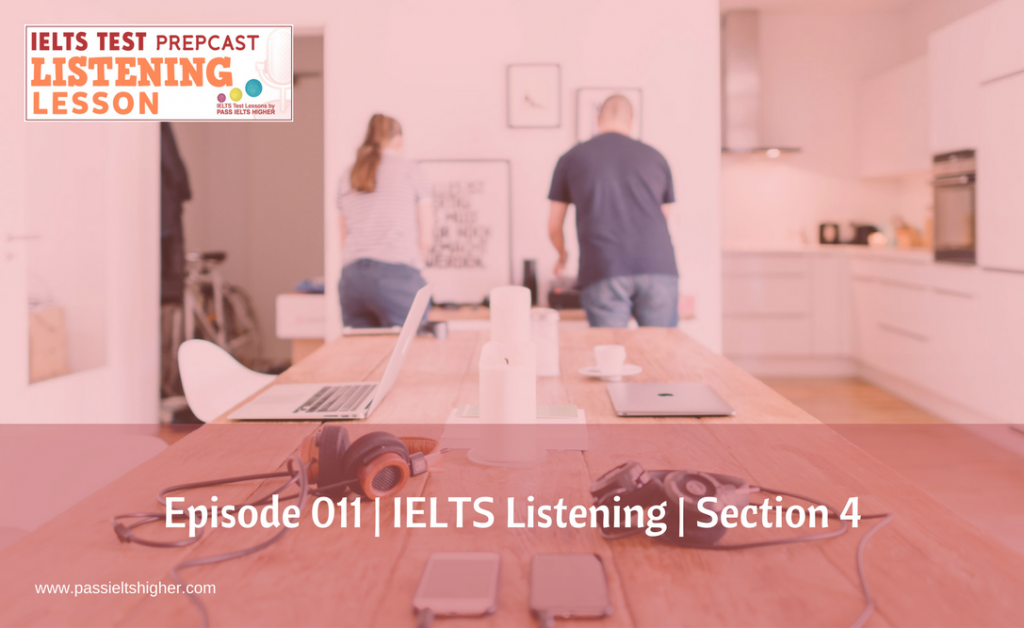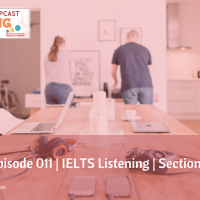

- Social:
- Link:
In this episode Andrea explains about Section 4 of the IELTS Listening Test and why it is the most important listening section if students are to perform well in Listening.
IELTS candidates will understand how easy it is to slip a whole bandscore if they do not heed the advice given.
Click here to be taken to iTunes where you can subscribe to all of the IELTS Test Prepcasts.
Podcast Transcript
IELTS Test Prepcast Episode 11
IELTS Listening: Section 4
I’m Steve Price. I’m the founder of the Pass IELTS Higher website, which was started in late 2010 and has been successfully helping students achieve higher band scores since. Andrea Price currently lives and works in London, teaching IELTS. She has been teaching the subject at home and abroad for over twenty years.
And now for today’s IELTS lesson.
Steve: Hello. Today we’re going to talk about IELTS listening, and in particular, we’re going to talk about section 4. I have Andrea with me again, and she’s going to take us through the elements of section 4, which students should be focusing on.
Andrea: Hello. If you’ve listened to previous podcasts, there have been podcasts about all the sections of listening, 1, 2, and 3. You will see that the listening sections get progressively harder, and section 4’s the hardest. If you’re looking for band 7, it will surely come from section 4, and if you practice lots of listening, you’ll realize that they get very hard. Section 4 is a lecture, the type you would get at a university, and it’s the most academic in style. Then before you start, in the exam, you are given time to look at questions in the sections. You’re given a listening booklet, and the listening booklet is in 4 sections.
Steve: Okay. Presumably, this is very analogous to skimming and scanning, where if you predispose your brain to what you’re going to—in case of skimming, that means reading, isn’t it—but in here, if you’re familiar with what you’re about to listen to, you can listen out for those things that are relevant to the question.
Andrea: Yes. No, that’s exactly right. Yes, that’s exactly right. Each section of the exam, in each section of the exam, the person speaking will tell you you’ve now got eight seconds or ten seconds to look at the listening book’s section 1 or whichever section you’ve arrived at. And the idea of looking at these sections is exactly as you say. You’re reading the questions, you’re pulling out the key words, you’re underlining the key words, so that when you listen, you can pull out the paraphrases.
Steve: Okay.
Andrea: Before the talk starts, you’re given time to look at the questions in sections. While you look at the questions, think about the kind of questions you’re about to answer. For example, there might be a section where you need to complete notes or sentences where you have to fill in a gap or multiple-choice questions. So as Steve said, it is quite similar to the reading. The questions they ask to you to complete are very similar to those in reading, so yes, you might have sentence-gap fills, tables to complete gaps with, summaries to make with gaps in. So very similar to the reading and the skill’s the same. You have to underline the key words and be aware of paraphrases with those keywords, then you read the section. Read the text that includes the gap fills to make sure you understand the idea in general. At the same time underline the key words just before and after the gaps. When you listen, you need to be able to find paraphrases of the key words you underlined. These paraphrases will guide you to the exact word from the script that you need to put in the gap. You don’t change that word. It has to be ad the person has spoken it.
Steve: Okay, and I think we’ve mentioned before that some of the gaps could be two words or three words.
Andrea: Yes, that’s a good point. At the top of the section, you will be given instructions. Make sure you read the instructions carefully. It’s quite often “write three words” or “write two words” or “write one word” usually with “and” or a number. I’ve never seen them asking you to write more than three words. You might think, “Oh, I’ve got four words and their answers sound right”. What you have to do then is remove the articles or remove the adjectives. Usually, they’re not important. Sometimes they are, but in general, you can say they’re not important. I’ll say remove “the”, but be careful. You might have to answer with something that there’s only one of, so just before the gap, you will have “a”. And in that case, you don’t remove it and you know that the noun that goes in the gap is singular. Another mistake that students make here is they put a noun in the gap but they forget, when you’re talking in general, the nouns are normally plural, so don’t forget to put your “s” on the noun. Otherwise, your answers will be wrong. Okay, the approach. This is a talk and it’s somebody talking to you, so giving a lecture about something. And you need to be able to follow the content and make notes at the same time to help jog your memory when you answer the questions. So that you can follow the talk and grasp the main ideas each time, you need to understand words which are used to sequence these. Now by underlining the words, you draw your own attention to the paraphrases you need. Sometimes, because the exam goes so quickly, it is actually sometimes quite hard to make notes while you’re listening. So what you should try to train yourself to do is listen for the paraphrases and maybe quickly note the paraphrases down because you’re going to choose an answer. But be careful. It’s not usually the first one you want to choose.
Steve: How many times, remind me please, how many times does the student get to listen to the audio?
Andrea: You only get to hear the listening once.
Steve: Okay.
Andrea: So that’s why it’s quite hard and that’s why the student is quite stressed
Steve: Okay.
Andrea: And another thing I would say, if you’ve missed an answer, just forget it. While you’re worrying about that answer, you’ll miss five more, and obviously, it only takes two answers to lose a band .5. So just forget. If your notes, or if you manage to make notes and you go back, you might be able to guess the answer to the question anyway, so try to train yourself not to worry if you’ve missed an answer. So how you also know what’s about to happen is that you’ll be listening for what they call signpost words or sequencing. To introduce a talk, the speaker will use words like “the first part of the seminar” or variations on the expression. When he continues to talk, you will hear expressions such as “the second part of” or “then”, “now”, and so that you know the talk is about to finish, you will hear phrases similar to “lastly, that’s about all I want to say”. So that’s just really helping you follow things sequentially and logically. Be prepared. When you hear the sequencing expressions, you need to make sure you are following the sequence as you’re being guided to the area where the answers to questions in the talk are. So it’s not as easy as it sounds. Of course, a bit easy for native speakers, but not always. You need to combine these skills. Combining the skills, section, example, 1. While you’re following the talk, you need to be aware of paraphrasing that links to the key words you have underlined before and after a gap in the listening booklet. These guide you to the word to put in the gap, which must be the exact word and not changed. To decide if you’ve chosen the correct word, check the word that comes just before the gap. Remember you’re also being checked about your knowledge of grammar, and your knowledge of grammar and parts of speech will help to make sure you put the right word in the gap.
Steve: Okay, so going back one of our previous lessons, if you’re using articles and you’re using “a something” or “an something”, then that could help. If you’re using singulars and plurals, then you could look for the precursor word for that as well
Andrea: Exactly. Yes, that’s exactly the point. Imagine you want to put “umbrella” in the gap, and the word that comes just before the gap is an “a”, you should realize that you’ve chosen the wrong word. So exactly, you’re knowledge of grammar and part of speech will help you here. Or if you want to put a plural noun in, and it says “a”, then you’ll know again you’ve made a mistake. “The” shows you need a noun because articles are about nouns. Remember those nouns are not, are usually plural and make sure your noun has an “s” when you write it down in the gap. “A” is pointing out the word for the gap is a noun and that it’s singular or there’s only one. “A” before the gap may also denote that you’re looking for a profession, so some of your knowledge is going to help you predict what goes in the gap.
Steve: And I guess this is, it’s worth reminding people here that there are some plural words which don’t have an “s” on the end, so “child, children”, and so on.
Andrea: Yes, that’s also a good point. I’ve given you a sweeping general rule, but Steve’s right. Of course, some nouns don’t always finish in “s”. Some plural nouns don’t always finish in “s”. But remember that the noun you want to put in is usually a plural. The second skills you need to combine are, thinking about this, the gap may have a noun after it, in which case you need an adjective or maybe a number. Another option is a verb. Another skill which is essential is an awareness of what is, what are called signpost words. These words signal that a change is coming, and usually that tells that you either that the one you want, the answer you wanted to choose is wrong, might be a negative signpost, like “not”, obviously “not” or “but” or “although”. They tell you that something else is coming but it’s the opposite idea, and that change usually has the answer in it.
Steve: Okay, so that’s been a useful counter through section 4. It does sound very complicated, especially knowing that they are only going to listen to the audio once. And so when students are preparing for this, what sort of preparation could they undertake?
Andrea: Right. What I think, what I always tell my students, and I think it’s a really easy way to prepare, is to watch television and make notes or make and take notes on what you’re listening to. This might not be useful unless you can have subtitles, so something I recommend is something like iPlayer. You can watch ten minutes of a program and make your notes. And then you can watch iPlayer again with subtitles, and you can see how accurate your note taking is if you compare it to the subtitles. And I just think that’s a really easy way to improve your skills because you’re just sitting at home watching television or a film or something.
Steve: Okay, so it doesn’t have to be an academic context.
Andrea: No.
Steve: Or track, so really it’s just getting used to just listening to the grammar that’s involved in people speaking.
Andrea: Yes, exactly. Listening to the most important words, being to pull out the most important words so that you can summarise the idea, and then from that you get more competent with your thinking about you grammar. I think
Steve: Okay, in the IELTS test in the audio record, they presumably never use anybody speaking who doesn’t speak grammatically correctly. So you don’t get people who perhaps aren’t as proficient in any of the audio.
Andrea: That’s a good point. I would say, yes, you’re right. They do use non-native speakers, but when I think about it, they’re normally fluent, yes.
Steve: Yes, that makes sense also.
Andrea: Yes, makes sense, yes.
Steve: Because it would seem a bit silly to be testing people on something where the actual grammar being used is incorrect.
Andrea: Yes. No, I agree. You just said about whether it should only be academic. Should you only watch programs which are a little bit more serious on television. No, you don’t have to because you’re asked to understand a variety of accents. Could be Australian, New Zealander, Canadian, American. Then they like you to listen to lots of local accents within Britain so you might hear a Scottish accent or an Irish accent or maybe somebody from the north of England. So if you’re watching any sort of program, you can also use this to help you get used to different accents that you might have to listen to. And I do believe that the more you listen—television because it’s easier but radio as well if you like—you’ll just get more used to understanding people who speak at speed. And if they pronounce things in a different way, again, you’ll be improving that if you’re watching all sorts of programs on the television.
Steve: Okay.
Andrea: One thing the IELTS candidates should remember or I’m sure aware of if you’ve taken a few exams is that in section 1, 2, and 3, you’re given time to listen to maybe half the questions. And then you answer those and then you’re given more time to listen to the second half of the questions in each section. Because section 4 is the hardest for the student and you also see how competent you are with your English, you’re not given any time to listen. It just goes straight through. So you’ve got to be able to read ten questions quickly, understand the key words, and then immediately listen to the paraphrasing.
Steve: Okay.
Andrea: So that is a bit hard.
Steve: Yes.
Andrea: You don’t get time to listen. Yes, you only get time to listen to everything in one go.
Steve: Right, how long typically is the audio?
Andrea: Probably five minutes a section.
Steve: Okay. Yes, so it is quite a challenge then.
Andrea: Yes.
Steve: Having to remember all the information. And I think even native speakers will find that challenging.
Andrea: Yes.
Steve: Okay, thank you for that. It’s been a very useful run through the IELTS listening section 4. I think we’ve met all the objectives that we wanted to touch on today. So until next time. Thank you very much.
Andrea: Thanks. Bye-bye.
You’ve been listening to the IELTS Test Prepcast, which provides three free IELTS lessons for candidates aiming for IELTS band score 7, 8, or 9. Subscribe to this prepcast in iTunes, or download it from our website, www.ieltstestprepcast.com.

Leave a Reply